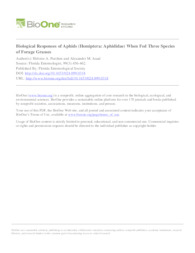Biological responses of aphids (Hemiptera: Aphididae) when fed three species of forage grasses.
Biological responses of aphids (Hemiptera: Aphididae) when fed three species of forage grasses.
Author(s): PARCHEN, H. A.; AUAD, A. M.
Summary: In Brazil, the forage species Brachiaria spp., Pennisetum purpureum (Schumacher), and Cynodon dactylon (L.) (Poaceae) are important components in the feed that is used to rear animals for meat and milk production. Aphids are among the insects that feed on these forage species and, at high population levels, greatly reduce the amount and quality of forage. Hence, the aim of this study was to determine the nutritional suitability of the forage species Brachiaria decumbens Stapf, C. dactylon, and P. purpureum for the aphids Sipha flava (Forbes), Rhopalosiphum maidis (Fitch), Hysteroneura setariae (Thomas), and Rhopalosiphum padi (L.) (Hemiptera: Aphididae). Nymphs, which were up to 24 h old, of the 4 aphid species were observed for a biological cycle (1 full generation) on the 3 species of forage. For each association between a species of plant and a species of aphid, 70 aphids were used to create the individual units. The number of instars and the duration and survival of each instar and nymphal stage were evaluated. Additionally, the longevity and the reproductive capacity were recorded for the adults of each aphid species, and a fertility table was prepared. These parameters of each aphid species were compared for each of the 3 species of forage supplied as food and for the identical forage. All aphid species completed their development cycles and produced offspring on all 3 species of forage. However, the duration, survival, and reproduction of the aphid species changed dependent on the nutritional suitability of the forage. For all of the aphid species, the forage P. purpureum provided the best conditions for population growth. When the aphid species were fed the identical forage, R. padi developed better and produced more offspring on all forage species. The 4 aphid species have the potential to be pests of P. purpureum, B. decumbens, and C. dactylon.
Publication year: 2016
Types of publication: Journal article
Unit: Embrapa Dairy Cattle
Keywords: Bermudagrass, Elephant grass, Nutritional suitability, Signal grass
Observation
Some of Embrapa's publications are published as ePub files. To read them, use or download one of the following free software options to your computer or mobile device. Android: Google Play Books; IOS: iBooks; Windows and Linux: Calibre.
Access other publications
Access the Agricultural Research Database (BDPA) to consult Embrapa's full library collection and records.
Visit Embrapa Bookstore to purchase books and other publications sold by Embrapa.

